Research Article
Astrophysics in Proliferation of All Species
6610
Views & Citations5610
Likes & Shares
The reproductive cycles of all species including humans adapt to the revolution period of the Moon. Human Female Menstrual cycle phases corresponds with the synodic motion of the Moon about 29.5 days to complete one cycle of phases (from new Moon to new Moon) which also corresponds with the period for fertilization of the egg and to mint the egg into a chicken by hatching. The sidereal motion of the Moon of synchronous rotation with the Earth once around its axis in 27 days also faces our two closest planetary neighbors, Venus and Mars alternately once in a month for a fortnight. Moon and Mars are the two permanent magnets. In “Jyotish”, they signify Female and Male genders respectively. The attraction and repulsion between Moon and Mars help in panspermia origin of living cells with sex chromosomes, male (X, Y) and female (X, X). Moon facing Venus is of no avail since Venus is bereft of any magnetism and in addition, rotates in the opposite direction. Lunar magnetism (Moon in conjunction with Mars) orchestrates Human Female Menstrual Cycle, copulation and conception which results in the birth of either male or female child “Omne vivum ex vivo” (“Every living thing from a living thing”. The present study explains the mechanism behind, corroborating with “Jyotish”, one of the six Vedāngas and ancillary to the ageless Vedas. Incidentally, the study unravels the “Chicken or the Egg Causality Dilemma” of how the cock and its seed do mint and coin the chicken out of the egg.
Keywords: Lunar Magnetism, Chromosomes, Panspermia, Menstrual Cycle, Jyotish, Vedanga, Vveda
INTRODUCTION
“Science without religion was lame and religion without science was blind” —Albert Einstein. Science and religious beliefs need not be in contradiction. If they are properly understood, they cannot be in contradiction because both science and religion endeavor for truth.
“Although it be a known thing subscribed by all, that the fetus assumes its origin and birth from the male and female, and consequently that the egge is produced by the cock and henne, and the chicken out of the egge, yet neither the schools of physicians nor Aristotle’s discerning brain have disclosed the manner how the cock and its seed doth mint and coin the chicken out of the egge.” —William Harvey (As quoted in John Arthur Thomson, The Science of Life: An Outline of the History of Biology and Its Recent Advances (1899), 126). This requires to know how a male and female originated in the first instance.
Ancient Hindus excelled in all subjects that afforded the largest field for abstraction and contemplation. It was therefore left to such a people to perfect the Science of “Jyotish” (Vedic Astrology). The works, mostly in Sanskrit, are of astounding precision and exactitude in their operation. “Jyotish”, one of the six Vedāngas and ancillary to the ageless Vedas, is defined as the study of effect of sunlight on the earth and all life living on it [1]. The selective adaptation of celestial bodies for its study are all those that cause sunlight on the earth directly, by reflection, by deflection and reflection and by modulation (Figures 1 & 2).
In fact, the very genesis of the principles of “Jyotish” is based on the principles of Astrophysics [2]. Sunlight is defined as an electromagnetic wave. Electromagnetic waves consist of two waves - one is an oscillating magnetic field and the other is an oscillating electric field, oscillating perpendicular to one another with their wavelengths/frequencies and energy which interact with matter. “Magnetism is one of the fundamental properties of the Earth; it is native and fundamental to our planet’s existence”. Research in magneto-biology has shown that a wide variety of organisms respond to changes in Earth's magnetic field [3]. For instance, humans are also sensitive to changes in Earth's magnetic field [4]. Recently, an interest is paid to the bio-magnetism as a special scientific field dealing with the influence of the global Earth’s magnetic field on humans. So, it became a diagnostic tool and a therapeutically procedure for many diseases” [5].
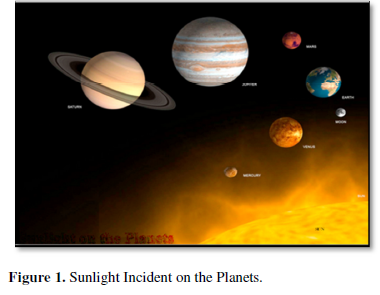
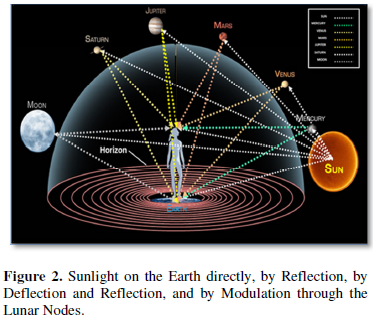


PLANETARY MAGNETIC FIELDS OF ASTROPHYSICS AND HUMAN BRAIN
The Moon orbits the earth once every 27.322 days which is also approximately equal for it to rotate once around its axis resulting in synchronous rotation which means the moon rotates exactly once every time it circles the Earth. In other words, the rate of spin of moon is tidally locked with its rate of revolution. Moon (Luna) and Mars have localized regions of enhanced magnetic fields most likely caused by remnant magnetization cores suggests that Moon and Mars once had stronger fields plausibly in the very beginning (Figure 3 & 4).
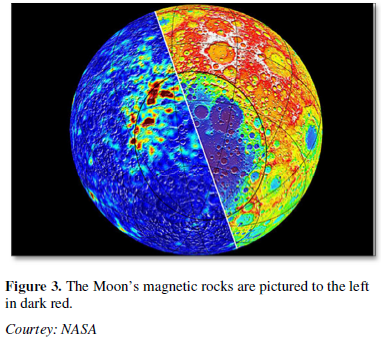
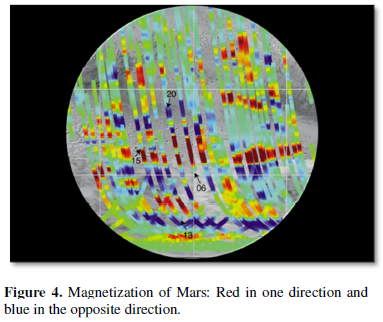


Out of our two closest planetary neighbors -- Venus and Mars, Venus rotates in the opposite direction and is bereft of any magnetic field while Mars has a magnetic field no more than 1/10,000th the strength of the Earth's. The most massive planet of solar system, Jupiter, has a magnetic field about 20,000 times stronger than ours. After about 4.3 billion years, today the core dynamos on the Moon and Mars are both extinct. Mercury and Earth are the only planets with magnetic fields generated by molten cores. The magnetic field created by Earth’s dynamo protects us from the solar wind by shielding a stream of charged particles of harmful X-rays and UV rays coming from the sun that could easily wipe away all living organisms. Our existence is more precarious and thus, our planet is aptly called the “Mother Earth”. Mother Earth’s natural heartbeat rhythm is the frequency of 7.83 Hz, also known as the “Schumann Resonance". A 7.83 Hz frequency is an alpha/theta brainwave frequency in the human brain. NASA [6] apparently has matched that of the human brain’s average alpha frequency. Implementing this design in human beings by any mechanism, other than the one described is beyond comprehension [7].
Lunar Magnetism Orchestrates Human Female Menstrual Cycle
Varāhamihira (520 A.D), Indian Astronomer and Astrologer of parlance, in one of his work “Brihat Jātaka” (Chapter IV Nishika (consummation of marriage) states:
- Menses that appear in women monthly, whenever the Moon is aspected by Mars, that is especially when the Moon occupies the 4th, or the 7th, or the 8th house from Mars i.e., 1200 or 1800 or 2400 away from Mars [8]. In connection with this subject, Kalyānavarma, the author of Sāravali says:
- “The Moon. is water is corroborated by NASA (2020 Oct) found abundant water on the surface of the Moon), and Mars is fire; a mixture of water and fire is bile; when the bile mixes with the blood menstrual discharge occurs” [9].
If when aspected by Mars, the Moon happens to occupy one of the Anupchaya signs in the horoscope or nativity of the woman, at the time of the appearance of the menses, conception will follow. The Upachaya signs are the 3rd, 6th, 10th and the 11th Houses from the Ascendant; and the other signs are known as Anupachaya signs.
Lunar Magnetism orchestrates human female menstrual cycle in the symphony of life (Figure 5 and Table 1) [10].
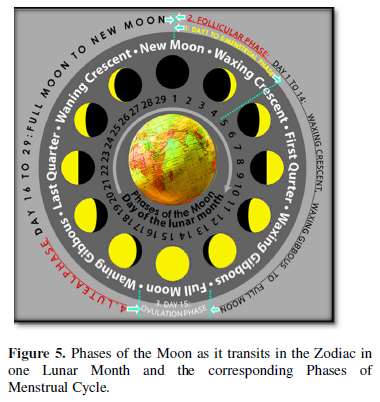
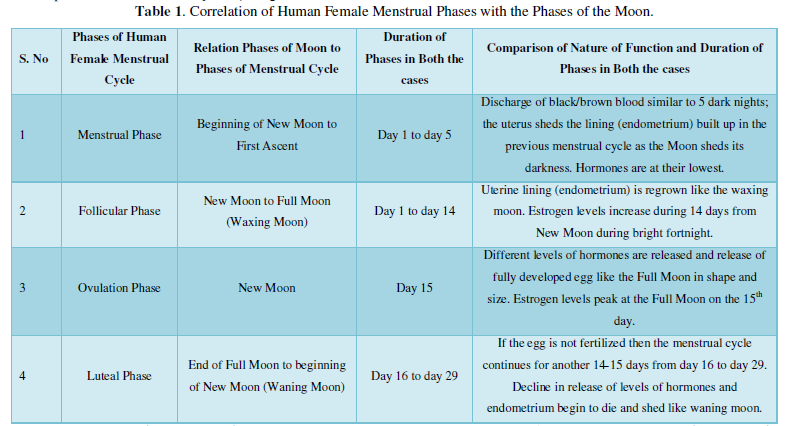


All life is a cosmic phenomenon. The entire process owes to the planets’ magnetism affecting the neural network. “The Sun, Moon, and planets telegraph their effects to us via magnetic signals”, Seymour [11] an astrophysicist and respected authority in the field of cosmic magnetism. Omnipresent throughout the universe, magnetism is known to affect the biological cycles of numerous creatures here on Earth, including humans. In sum, Seymour's multi-link theory proposes that the planets raise tides in the gases of the Sun, creating sunspots and their particle emissions, which then travel across interplanetary space to strike Earth's magnetosphere, ringing it like a bell. These planetary magnetic signals of myriad frequencies are then perceived by the neural network of the fetus inside the mother's womb, heralding the child's birth. This is corroborated by Jyotish, a Vedānga, which states that Moon and Mars bring about female menstrual cycle and conception. In Jyotish, the selectively adapted 7 celestial bodies and the 27 Lunar Constellations together with the 12 Signs of the Zodiac as means of its studies signify the three genders (Masculine, Feminine and the Neuter genders), all sum up to 46 plausibly indicating the number of human chromosomes (Table 2) [12].
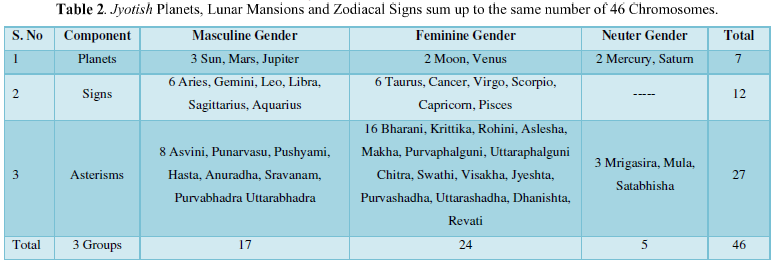
Also, these three types of astronomical components, Planets, Signs and Asterisms match with the number of chromosomes 46 in respect of their three groups, viz., large, medium and small (Table 3) [13].
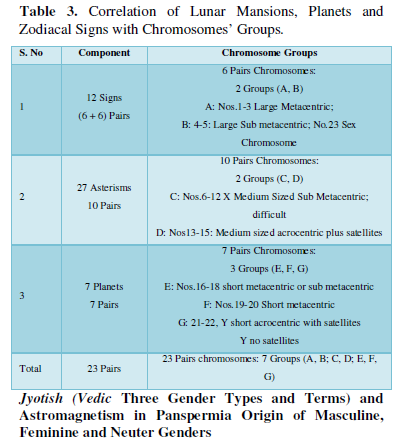

One single element of the genome, the Y chromosome, which is solely responsible for morphological and physiological differences between males and females, determines the difference between sexes, Male and Female. Y chromosome is present only in males. The two sexual chromosomes in men are X and Y, whereas the two sexual chromosomes in women are X and X. The first sexual beings called isogamous, which is like being gay, plausibly emerged 2.5 billion years ago during early Proterozoic Era. Many organisms, including some fungi, algae and single-celled pond-swimmers, still practice isogamy [13]. “First sex-determining genes plausibly appeared in mammals some 180 million years ago around Jurassic Period of Mesozoic Eon. A very long time ago, the X and Y were identical, until the Y started to differentiate from the X in males. It then progressively shrank to such an extent that, nowadays, it only contains about 20 genes (the X carries more than one thousand genes).
Weak “Y” Chromosome
In Hindu culture, the term “Gotra” is commonly considered to be equivalent to clan. It broadly refers to people who are descendants in an unbroken male line from a common male ancestor or patrilineal [14]. It broadly refers to people who are descendants in an unbroken male line from a common male ancestor or patrilineal of Saptarishis. “The word Gotra denotes the progeny (of a sage) beginning with the son’s son.” The progeny of the seven sages known as ‘Saptarishis’ (Seven Stars of Ursa Major) are declared to be Gotras. The classification of Gotra came into existence in Vedic period. This Gotra custom was established to avoid marriages between blood relatives (Consanguinity). The ‘Y’ chromosome is the only chromosome available in the male’s body. There is no similar pair in the human body. ‘X’ chromosome is significantly different from ‘Y’ chromosome. Even the size of the ‘Y’ chromosome is just about one third the size of the X chromosome. The size of the ‘Y’ chromosome has been decreasing since ages and it has lost most of its genes and is reduced in its size. It is debatable whether ‘Y’ chromosome will be able to survive into the future or will gradually vanish for, no other chromosome in our body will be able to completely take over its functionality. Unlike other chromosomes, there is no way for ‘Y’ chromosome to repair itself because all other chromosomes come in similar pairs. Both the chromosomes in all other pairs are almost identical in nature. When the DNA of one chromosome is damaged, the cell can repair it by copying over the DNA from the other chromosome in that pair [15].
Astrophysics in the origin of Masculine, Feminine and Neuter Genders in Panspermia Origin of Life
In “Jyotish”, Jupiter, Mars and Sun are male planets. Venus and Moon are female planets. Mercury and Saturn represent transgender, plausibly classified with the underlying idea of their magnetism. This property of the planets is correlated with the magnetism of the planets (Table 4) [16].
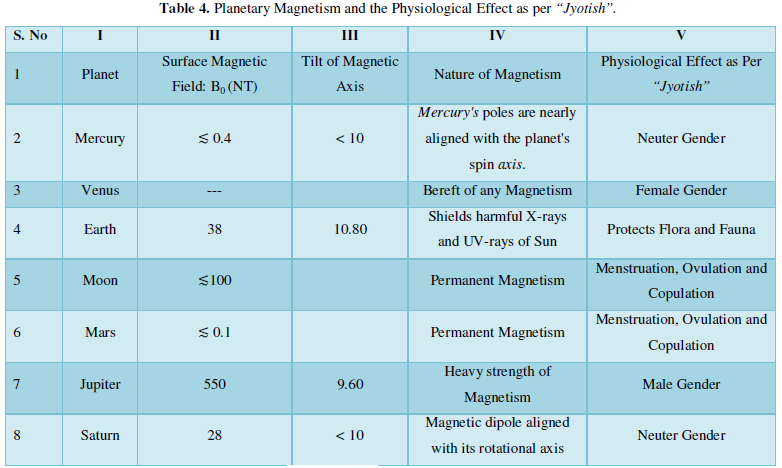

A close look at the above table reveals that out of our two closest planetary neighbors, Venus and Mars, Venus is bereft of any magnetic field while Mars has a magnetic field no more than 1/10,000th the strength of the Earth's. Moon and Mars have patches of permanent magnets. Adjacent magnetic fields vibrating harmonically can cause resonance in each other and transfer information between them. The most massive planet of solar system, Jupiter, has a magnetic field about 20,000 times stronger than ours. Many planets have large magnetic fields of their own, as does our Earth but Venus has none while the Moon and Mars are patchy, both being considered to be largely non-magnetic. However, even non-magnetic planets as they move in their orbits are affected by and react to the ionized plasma of the solar wind, which produces large electric fields around them that are conductive and cause disturbances in the IMF. Latest research hints that the passage of the moon in its orbit disturbs the Earth’s own field in a major way, similar to that of the IMF. Mars has a day and night cycle similar to Earth. Mars rotates on its axis once every 24.6 h. Planetary magnetism correlation is matching one to one with the ‘Vedic Thought’ in terms of sex (male or female or neuter genders) menstruation, ovulation, copulation and child birth [17]. The following two figures (Figures 6 & 7) are self-explanatory regarding origin of living cell defined in terms of male and female. In “Jyotish”, Jupiter signifies male sex. Jupiter possessing maximum magnetic field strength aspects Moon and Mars in conjunction, results in panspermia origin of living cell with male sex chromosome, or results in the birth of male child in evolution.
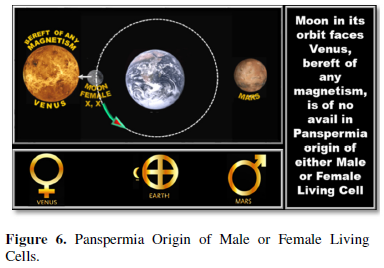
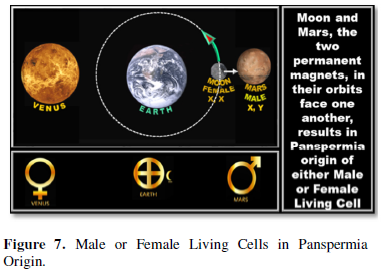
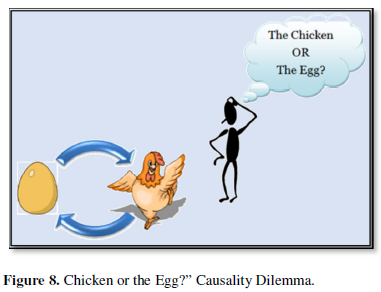



CHICKEN OR THE EGG?” CAUSALITY DILEMMA UNRAVELED
“Chicken or the Egg?” Causality Dilemma” (Figure 8) is born out of the most mysterious problem of ‘Origin of Life’. Origin of Life is the hardest question in science. No one knows how the first cell came about. How do cells “know” how to evolve? Although it is a known thing subscribed by all, that the fetus assumes its origin and birth from the male and female, and consequently that the egg is produced by the cock and hen. How the cock and its seed mint and coin the chicken out of the egg are all questions unanswered. All living organisms, including humans, have an internal, biological clock that helps them anticipate and adapt to regular rhythm of the day. Plants, animals and humans adapt their biological rhythm so that it is synchronized with the Earth's revolutions [17].
Reproductive Anatomy in Chicken
Most hens will lay their first egg around 18 weeks of age. They lay an egg almost daily thereafter; occasionally they skip a day. Hens lay eggs during the day, most frequently in the morning.
Egg production rates vary with length and timing of photoperiod and influence the time of day an egg is laid. The need of a rooster to get an egg right is not absolute. In their first year, one can expect up to 250 eggs on an average from backyard chickens. A laying hen won't ovulate or lay eggs in the dark. Roosters are the members of the flock who have a reputation for crowing when the sun comes up every day. This biological rhythm in the hens is synchronized with the Earth's rotation. Life on Earth is adapted to the rotation of our planet. If the hen has no access to a rooster, Eggs will be unfertilized. Unfertilized eggs will never develop into a chick. A rooster is needed to get a fertilized egg. A hen who has mated will be fertile between 7 and 10 days, on an average in 8.5 days after mating. It takes that long for the sperm to reach the oviduct where eggs are made (Figure 9).
Egg production rates vary with length and timing of photoperiod and influence the time of day an egg is laid. The need of a rooster to get an egg right is not absolute. In their first year, one can expect up to 250 eggs on an average from backyard chickens. A laying hen won't ovulate or lay eggs in the dark. Roosters are the members of the flock who have a reputation for crowing when the sun comes up every day. This biological rhythm in the hens is synchronized with the Earth's rotation. Life on Earth is adapted to the rotation of our planet. If the hen has no access to a rooster, Eggs will be unfertilized. Unfertilized eggs will never develop into a chick. A rooster is needed to get a fertilized egg. A hen who has mated will be fertile between 7 and 10 days, on an average in 8.5 days after mating. It takes that long for the sperm to reach the oviduct where eggs are made (Figure 9).
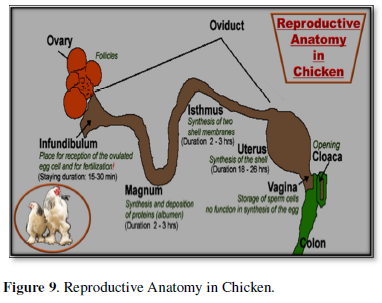
Once the rooster DNA is delivered to the hens, DNA in the germinal disc, they fuse together and become a zygote (fertilized seed). From now on It takes about 5 h for cell division to start when it is called embryo. Gestation is the period of time between mating and fertilization period is about 8.5 days on an average in hen. Fertile chicken eggs take around 21 days to hatch. Thus, on an average, it takes 28 to 30 days (one synodic month of 29.5 days) for the complete process (fertilization of egg to minting into a chicken). A rooster is genetically programmed to take the task of populating the world with his offspring. Courtship, mating and raising brood starts in the springtime (March 22 to June 22) in the Northern Hemisphere. In spring the weather usually turns warmer, trees begin to grow their leaves, plants start to flower and young animals such as chicks and lambs are born.
The increase in daylight energizes the hormones and the increase in hormones leads to procreation behaviors. The pineal gland in the chicken’s brain detects the increase in light and in turn stimulates the manufacture of hormones responsible for increasing egg production. These hormones by turn produce a cascade of other hormones necessary for the development of the yolk and the soon to be embryo. Hundreds of egg follicles of mitochondria DNA act as a sort of antenna and the DNA are genetically predisposed to hear specific planetary signals from the earth [18]. Sun’s magnetic field will encompass our whole system and beyond. This combination of solar wind and the magnetosphere of the Sun is known as the Interplanetary Magnetic Field (IMF) and extends far into interstellar space, engulfing the whole solar system [19]. IMF strikes the earth’s magnetosphere of myriad frequencies pulsating at 7.83Hz (Schumann Resonance). Earth then telegraphs these signals across the organisms living on earth through their DNA and translated to proteins when the proteins in the cell vibrate [20], and the organism which is on that particular frequency alone responds in evolution, much as a radio is resonantly tuned to receive a particular station, while minting the egg into a chicken.
CONCLUSION
‘Stars produce specific chemical elements at distinct phases in their life cycles [21] it could turn out that the solar system synthesizes and originate living cells of all genders under abiotic conditions of specific life forms and propelled to the earth by star dust for evolution at regular intervals of geological time scales as revealed by distinct phases in their evolution. Life on Earth may have been carried here in streams of star dust propelled at very great velocities throughout planetary systems including on the mother earth [20] for evolution due to Jupiter-Saturn orbital resonance causing climate changes at regular geologic periods providing diversification of species [2]. Once life began on earth, it could proliferate until it filled the planet. All living species on Earth seem to obey the rotations of the Earth (24 h/day) and the Moon 29.5 days (lunar month) [22].
The fact that the above concept of evolution and proliferation is a correct view of the matter is evidenced by the following scientific findings:
- The genesis of all principles of “Jyotish” (VedicAstrology) are based on modern sciences such as Astronomy, Astrophysics, Astrobiology, Mathematics, Metaphysics, Philosophy, Humanities, etc. [23].
- Sunlight defines life as an emergent property of matter [24].
- Fully supports Panspermia Origin of Life [25].
- “Life on Earth is adapted to the rotation of our planet” [24].
- Lunar magnetism orchestrates human female menstrual cycles in reproduction [18].
- Horoscopy proves heredity and serves as a forensic tool in disputes of paternity and maternity as striking planetary similarities are observed for parents and their children of their respective birth times similar to matching bands in DNA Fingerprinting establishing heredity [10,26].
- The number of 3 x 106 DNA entries required and the number of Astrological charts required to differentiate one from the other are identical [27].
- Pregnant women spontaneously deliver more often during a Full Moon [28].
- Women's Menstrual Cycles Begin More Often during a New Moon [29].
- An interesting 1990 study in the journal Psychiatry Research found that bright light at night can help regulate the menstrual cycle. In the study, women with abnormally long cycles of about 45 days who slept with a 100-watt bulb turned on at night in their bedroom from Day 13 to Day 17 of their cycle successfully shortened their cycles to about 33 days [30].
- Unravels the complexity of brain such as consciousness and transcendental consciousness in human. Each of the species living on earth too have a specific frequency of its own resonating with the earth’s magnetism (Schuman’s Resonance of 7.83Hz) harmonically with the exception human beings, with irreducible complex organs, tuned fundamentally to the natural harmonic frequency of the Earth of 7.83Hz, arrived last and evolved all over the globe, thus, remains unique from all other species. The earth’s frequency of 7.83 Hz apparently has matched that of the human brain’s average alpha frequency. Implementing this design in human beings by any mechanism, other than the one described is beyond comprehension [31].
FUNDING
This research received no external funding. Retired from service 2 decades back, now an octogenarian. Presently not associated with any institution.
- Rao YVS (2021) Definition of Vedic Astrology. Int J Res Granthaalayah 9(3): 102-108.
- Rao YVS (2019) Sunlight in the genesis of principles of Jyotish (A Vedānga). Int J Jyotish Res 4(2): 41-48.
- Brown Jr F A, Webb H M, Bennett M F (1958) Comparison of Fluctuations in Cosmic Radiation and Organismic Activity during 1954, 1955, and 1956. Am J Physiol 195(1): 237-243.
- Baker RR (1987) Human navigation and magnetoreception: The Manchester experiments do replicate. Animal Behav 35: 691-704.
- Cingoski V, Petrevska B (2019) From Global Earth’s Magnetic Field to Therapeutic Experience: Towards a Theoretical Framework for Developing Tourism Product. J Appl Econ Bus 7(3): 23-29.
- NASA (2013) What is Schumann Resonance and Why it is Important for Your Health. Available online at: https://www.drskinhealth.com/blog/schumann-resonance
- McCraty R (2003) The Energetic Heart: Bioelectromagnetic communication. An N Y Acad Sci 1008(1): 31-47.
- Sastry PS (1995) “Varāha Mihira’s Brihat Jataka,” publ: Ranjan Publications, New Delhi.
- Varma K (1977) “Sarāvali,” (1907) Publn: Motilal Banarsidass.
- Rao YVS (2019) Lunar Magnetism Orchestrates Menstrual Cycle in Symphony of Life. Am J Biomed Life Sci 7(5): 104-109.
- Seymour P (1986) “Cosmic Magnetism” Bristol, UK: Adam Hilger.
- Rao YVS (2016) Vedic Astrology in the Quest of Origin of Life, Evolution and Liberation, Publn: Sri Venkateswara Vedic University, Tirupati. ISBN: 978-93-81887-77-6.
- Cortez D, Marin R, Toledo-Flores D, Froidevaux L, Liechti A, et al. (2014) Origins and functional evolution of Y chromosomes across mammals. Nature 508: 488-493.
- Swiss Institute of Bioinformatics (2014) Male or female? First sex-determining genes appeared in mammals some 180 million years ago. Science Daily.
- Rao YVS (2019) Astronomy in Hindu religion and culture. Int J Jyotsih Research 4(2): 49-56.
- Rao YVS (2021) Vedic Thought and Modern Genetics on Consanguinity. BioMed Res J 5(2): 408-412.
- Rao YVS (2016) Vedic Astrology in the Quest of Origin of Life, Evolution and Liberation. Publn: Sri Venkateswara Vedic University Tirupati. pp: 177. ISBN: 978-93-81887.
- Hall JC, Rosbash M, Young MW (2017) Discoveries of molecular mechanisms controlling the circadian rhythm research a collection from The Company of Biologists.
- Cann RL, Stoneking M, Wilson AC (1987) Mitochondria DNA and human evolution. Publ: Nature 325(6099): 31-36.
- Harwood C (2009) Astrology - A Magnetic Attraction, first published by The Astrological J 2009 / The Astrological Association of Great Britain / 01.02.2017.
- Markelz A, Niessen K, Snell E (2014) Measurements and calculations of protein intramolecular vibrations in the THz range. International Conference on Infrared, Millimeter, and Terahertz Waves.
- Berera A (2017) Space Dust Collisions as a Planetary Escape Mechanism. Astrobiology 17(12): 1274-1282.
- Etz D V (2000) Conjunctions of Jupiter and Saturn. J Royal Astr Soc Can 94: 174-178.
- Rao YVS (2021) Advanced Panspermia Origin of Life and Evolution. Am J Astr Astrophys 7(4): 54-66.
- Rao YVS (2016) Vedic Astrology Reintegrated into Astronomy. Publ: Sri Venkateswara Vedic University, Tirupati, India. ISBN 978-93-81887-74-5.
- Gauquelin M (1988) “Planetary Heredity,” San Diego, CA: ACS Publications, Text ISBN 10: 0935127011 / ISBN 13: 978093512701.
- Rao YVS, Rao YVR (2017) DNA Finger Printing and Horoscopy for Determining Paternity or Maternity of a Child. Mathe Lett 1(3): 53-57.
- Ginecol (1997) Pregnant Women Spontaneously Deliver More Often during a Full Moon. Italian J Minerva 49(3): 91-94.
- Law SP (1986) The regulation of menstrual cycle and its relationship to the moon. Acta Obstet Gynecol Scand 65(1): 45-48.
- Encyclopaedia Britannica (1994) Macropaedia. Animal Behav pp: 761.
- Rao YVS (2020) Human Beings’ Birth, Death and Beyond. Int J Res-Granthaalayah 8(9): 404-414.
QUICK LINKS
- SUBMIT MANUSCRIPT
- RECOMMEND THE JOURNAL
-
SUBSCRIBE FOR ALERTS
RELATED JOURNALS
- Journal of Ageing and Restorative Medicine (ISSN:2637-7403)
- Archive of Obstetrics Gynecology and Reproductive Medicine (ISSN:2640-2297)
- International Journal of Radiography Imaging & Radiation Therapy (ISSN:2642-0392)
- Journal of Otolaryngology and Neurotology Research(ISSN:2641-6956)
- Chemotherapy Research Journal (ISSN:2642-0236)
- International Journal of Internal Medicine and Geriatrics (ISSN: 2689-7687)
- Journal of Oral Health and Dentistry (ISSN: 2638-499X)











